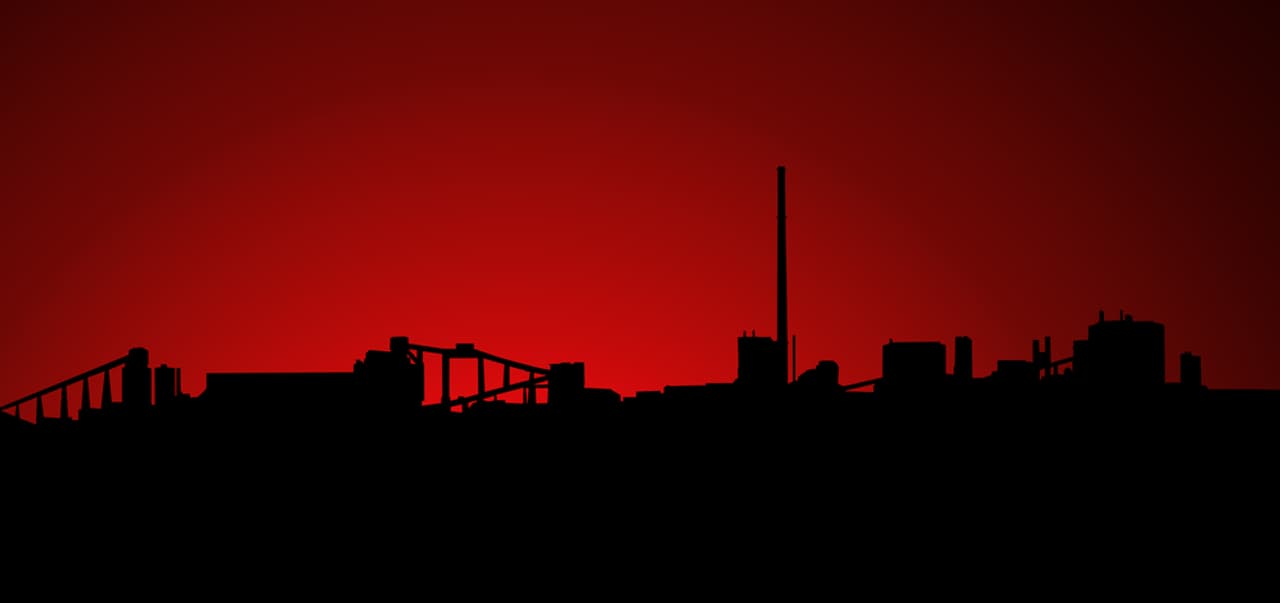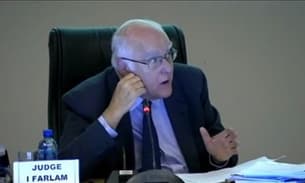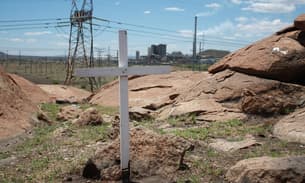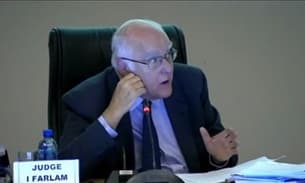
The Marikana massacre in the words of the victims
(Image from Shutterstock)
Back in August the world watched aghast as televised footage showed South African police opening fire on striking miners at the British-owned Lonmin mine in Marikana, South Africa. Since that date both journalists and a government backed inquiry have poured over the details of what happened on August 16, trying to piece together the events that led to the worst massacre on South African soil in over three decades.
The Farlam Commission, the inquiry set up to investigate the massacre, has already run into problems with key witnesses claiming interrogation from the police force, as reported by the Bureau.
Related article: Arrests and intimidation plague victims of Marikana massacre
Now several South African academics are criticising the commission for failing to focus sufficiently on the testimony of the workers who were actually involved in the strike.
Professor Peter Alexander, head of sociology at the University of Johannesburg, is one of five South African authors of Marikana: A view from the mountain and a case to answer, a new book based on interviews and witness accounts of the massacre.
Speaking at the launch of the book yesterday Alexander called the Farlam Commission ‘a lawyers’ paradise’ with the legal profession providing the evidence and little being heard from the victims. ‘Their pain and suffering is not being brought to the commission’s chairman. It is not neutral,’ he added.
Silencing the masses
Media coverage of the event has done little more to give a voice to the workers involved. Marikana: A view from the mountain and a case to answer reports that analysis of news coverage in South Africa after the massacre showed that the voices of the workers were simply not getting through. According to the researchers of the book, nearly a third of those quoted in the press were business sources, 14% were managers and owners of mines. Only 3% of those quoted in the press were workers.
‘[The workers] pain and suffering is not being brought to the commission’s chairman. It is not neutral’
Professor Peter Alexander, University of Johannesburg
The authors go on to provide a scathing criticism of the press’s work on the matter, stating that ‘with honorable exceptions, journalists lacked the credibility, commitment and patience to build the trust necessary to get the workers’ story.’
Stories from the ground
In order to redress the balance, the book’s authors undertook formal interviews with 30 of those involved, they joined workers and community representatives for their meetings, participated in protests and ‘engaged in countless unrecorded conversations’.
The result is a set of interviews, witness statements if you like, that provide a vital insight into what drove the Marikana miners to strike, what made them keep up their protest even in the face of threats of violence and what, in their words, happened on the mountain that day in August.
Ten of the mineworkers’ testimonies are reproduced in the book, each provided anonymously so as to protect them from repercussions. Together these stories give a clear picture of what it is like to work in a job that is exhausting, dangerous and poorly paid.
Related article: South African massacre was the tip of an iceberg
The miners that first went on strike were rock drill operators, responsible for operating the drills that would carve out stone before it is cleaned and blasted with explosives to extract the platinum inside. The work requires extreme concentration and workers are often at risk of injury from rocks falling on them. Despite all this, they are paid around 4000 Rand (about £285) a month, and required to work long shifts.
‘With honorable exceptions, journalists lacked the credibility, commitment and patience to build the trust necessary to get the workers’ story.’
Marikana: A view from the mountain and a case to answer
‘According to the law we are supposed to work 8 hours, but we don’t work for 8 hours. We work for 12 hours and even 13 hours,’ one mineworker claims.
Conditions many allege can prove hazardous. ‘We work under a lot of pressure from our bosses because they want production and then there is also intimidation. They want you to do things that are sub-standard and if you don’t want to do that and follow the rules… they say they will fire you or beat you,’ claims another mineworker.
Race also has a role to play in the story. One mineworker attests ‘a white person here in the mines gets a better pay than a black person and they are more eligible for promotion and that oppress[es] us black people more.’
It was conditions such as these, the miners say, that led them to strike in the first place, demanding a pay increase to 12,500 Rand (around £890) a month.
The bullets start to fly
So it was that on August 11 a group of striking miners set out to talk to Lonmin about their complaints. Through the testimony of the ten mineworkers the book recounts how that process went. According to the interviews the miners decided not to consult the official Lonmin-recognised union, the National Union of Miners (NUM), deciding that the union was no longer representing their needs.
Instead a group of miners set off for the Lonmin offices singing and chanting as they went. The authors of the book are adamant that the miners were not armed at this time, ‘not even with traditional weapons.’ However, video footage that has come to light in the Farlam Commission indicates that some of the protestors were carrying traditional weapons when they approached the offices. No incidents of violence were captured on film.
At the Lonmin office they were told they must speak through their union and so they made the journey to the NUM offices. When they arrived they claim that security personnel outside the offices opened fire, killing two of the protestors.
‘We work under a lot of pressure from our bosses.. They want you to do things that are sub-standard and if you don’t want to do that… they say they will fire you or beat you,’
Mineworker’s testimony
A few days later on August 16, the protesters took with them spears and traditional knives, a gesture many of those interviewed explain as ‘following tradition’ and ‘habit’, rather than aggressively arming for a battle they say. The police claim, however, that the protesters were armed.
Later photographs in the Guardian appeared that seemed to show the police may have planted weapons next to dead bodies to justify their deaths.
Related article: Fresh allegations of cover-up in Marikana massacre
The protesters had occupied a mountain side near the mine and were waiting there when the police force arrived in armoured vehicles. The testimonies in the book then relate how the protestors watched as police rolled out razor wire, fencing them in. Many suggest they felt they were being penned like animals.
When some tried to leave through a gap in the wire armed police began firing at the men, both from the ground and from helicopters hovering overhead. Several of the testimonies suggest there were no warning shots fired, and few rubber bullets used. Instead the police shot to kill, the protesters allege.
Tear gas and large armoured vehicles were used and in the resulting chaos many protesters were crushed under the police’s Nyala Armoured Patrol Vehicles.
Water cannons were also employed but many of the interviewees state that this only happened after the first bullets were fired, suggesting the police had not exhausted all non-lethal means of crowd control before they started firing. Automatic weapons were also reportedly used.
Thirty four miners were killed that day and 78 injured. A further ten people were killed in the days before, including two police officers.
Exploring who was responsible
The report then works to de-bunk theories put out about the massacre. According to the authors the story put forward by Lonmin, the South African Police Service and the Minister of Mineral Resources is that the violence stemmed from a dispute between the miners’ unions. The NUM had official bargaining rights with Lonmin but many workers had turned to the Association of Mineworkers and Construction Union (AMCU) to voice their complaints. Suggestions have been made to the Farlam Commission, by Lonmin’s legal team, that infighting between these two unions exacerbated a fraught situation and resulted in the violence.
However the massacre affected those aligned to NUM and AMCU almost equally, the researchers’ analysis of the deaths shows that 11 were NUM members and 17 were from AMCU, the rest were without union allegiances. This suggests that while there may have been in-fighting among union officials, the protesters themselves were united in their cause.
The second theory explored by the authors is that the striking miners charged at the police because they were ‘high’ on muti, a natural remedy provided by traditional healers. The authors reject this notion, concluding that this story was ‘part of a discourse depicting the strikers as frenzied savages.’ The writers also note that even if this were true the striking miners they believe were only armed with sticks and spears – little match for the razor wire, automatic weapons and helicopters employed by the police.
Indeed, the report notes that the police dispatched to deal with the strike were special paramilitary units trained to deal with highly violent heist situations, not crowd control.
Ronnie Kasrils, former ANC Minister of Intelligence is quoted in the report, saying ‘These people were hardly occupying some strategic point, some vital highway, a key city square. They were not holding hostages. They were not even occupying mining property. Why risk such a manoeuvre other than to drive the strikers back to work at all costs on behalf of the bosses who were anxious to resume profit making operations.’
According to the book, autopsy reports show 14 of the striking miners were shot from behind.
[These people] were not holding hostages. They were not even occupying mining property. Why risk such a manoeuvre other than to drive the strikers back to work at all costs on behalf of the bosses who were anxious to resume profit making operations.’
Ronnie Kasrils, former ANC Minister of Intelligence
Lonmin
Caught right in the centre of this is London registered Lonmin, the platinum mining company employing the miners.
In 1973 Edward Heath described Lonrho, now known as Lonmin, as ‘an unacceptable face of capitalism’. The company has gone through much change since then, but forty years on and there are still those critical of the company. In 2007 two academics (Bezuidenhout and Buhlungu) noted that there were reports of jobs at Lonmin’s Karee mine being sold and that one worker claimed that ‘the price of a job was R1500, half of which went to the shaft steward and the other half to the person in the human resources department of the company.’ One of the workers interviewed for this 2012 report alleged that the practice still existed.
Lonmin refuted this claim saying ‘The company does not tolerate any such practice and has a reporting process in place that allows for anonymous reporting of all forms of unethical behaviour.’
In the end the company did agree to a 22 per cent pay increase for the rock driller operators who were protesting, though only after the strikers continued to picket for days after the massacre.
‘Our training complies with and generally exceeds all regulatory requirements. When we settled our dispute our priority was safety and we spent six days re-orientating trained miners prior to starting production.’
Lonmin spokesperson
The Bureau put some of the allegations in the book to Lonmin. They said, ‘Lonmin has established a safety culture within its mining operations, which is the best among its peers. It is simply untrue to suggest that workers are sent underground without any training. Every employee receives competence, annual refresher, team effectiveness, life skills and communication training.
‘Our training complies with and generally exceeds all regulatory requirements. When we settled our dispute our priority was safety and we spent six days re-orientating trained miners prior to starting production.’
When asked about the notion that mineworkers worked longer than 8 hour shifts, faced sub-standard conditions, and that white workers were favoured for promotion over their black colleagues Lonmin said, ‘This alludes to business practices that are both unethical and out of line with company policy. Should anyone have evidence of such things taking place we will investigate.’
Another piece in the puzzle
Marikana: A view from the mountain and a case to answer is not the definitive explanation of what happened on the mountain side that day, but it does provide clues.
The authors suggest ‘There is what one might call a triangle of torment linking Lonmin, the police and NUM.’ The book does not quite get to the bottom of explaining how this triangle actually functions. It is a very one-sided account. We do not get interviews with the police or Lonmin, which means neither side has any proper representation in the book.
However it is a hugely important work, giving a vital ‘bottom-up account’ of events. These testimonies certainly need to be cross referenced and explored, but the opportunity to give a voice to the voiceless cannot be underestimated. After all, the striking miners of Marikana only ever wanted to be heard in the first place.
The book Marikana: A view from the mountain and a case to answer is published by Jacana in South Africa and will be co-published by Bookmarks Publication UK in January.




